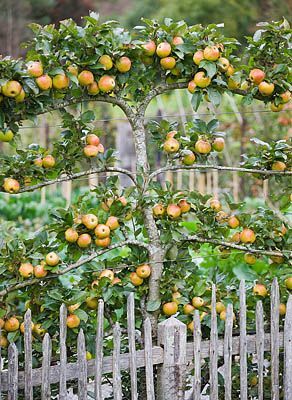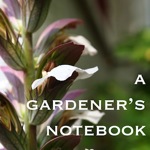Espalier Fruit Trees
Today’s entry to more about a style of plants, rather than an individual plant. espalier fruit trees have been a part of gardening since and have always fascinated me. They are a bit of work to maintain, but fit in so well with certain aspects of gardens — like walls and fences. Espalier methods can turn even the smallest garden into a productive garden with a little work.
Discovered via Pinterest User, Bianca Lemos Felga
Espalier (/ɨˈspælɪər/ or /ɨˈspæli.eɪ/) is the horticultural and ancient agricultural practice of controlling woody plant growth for the production of fruit, by pruning and tying branches to a frame, frequently in formal patterns, flat against a structure such as a wall, fence, or trellis, and also plants which have been shaped in this way.[1]
Espaliers, trained into flat two-dimensional forms, are ideal not only for decorative purposes, but also for gardens in which space is limited. In a temperate climate, they may be planted next to a wall that can reflect more sunlight and retain heat overnight or planted so that they absorb maximum sunlight by training them parallel to the equator. These two facts allow theseason to be extended so that fruit has more time to mature.
A restricted form of training consists of a central stem and a number of paired horizontal branches all trained in the same plane. The most important advantage is that of being able to increase the growth of a branch by training it vertically. Later, one can decrease growth while increasing fruit production by training it horizontally.
A Belgian fence is created by cutting back an unbranched, slender tree to between fifteen and eighteen inches above the ground. The topmost three buds are allowed to form; one in the middle is trained vertically while two others are trained into a V shape. Any other buds are rubbed away. Removing the vertical stem completes the individual V-shaped espalier. By placing many similarly trained trees in a line two feet apart with their branches trained to the same plane, a Belgian fence is created. — Wikipedia
- Espalier at Wikipedia
- How to Espalier at Better Homes and Gardens
- How to Espalier from Mother Earth News
Previously in the Interesting Plant series:
- California Poppy (Eschscholzia californica)
- Hydrangea ‘Zorro’
- Harlequin flower (Sparaxis tricolor)
- Erythronium
- Sempervivum
- Primula auricula
- Feathery Cassia (Senna auricula)
- Red Stick Dogwood (Cornus alba ‘Sibirica’)
- Japanese Maple (Acer palmatum)
- Kousa Dogwood (Cornus kousa)
- Giant Chalk Dudleya (Dudleya brittonii)
- Sunrose (Helianthemum nummularium)
- Australian/New Zealand Tea Tree (Leptospermum scoparium)
- Brugmansia Sanguinea
- Calico Monkeyflower (Mimulus pictus)
- Colocasia Esculenta
- Acer palmatum ‘Sango-kaku’ (Coral Bark Japanese Maple)
- Linderniaceae (formerly Torenia) Kuaui Deep Blue
- Passiflora (Passion flower)
- Firewheel Tree (Stenocarpus sinuatus)
- Anemone
- Allium Cowanii
- Symphyotrichum oblongifolius (Purple Aster)
- Hemerocallis ‘Derrick Cane’ (Daylily)
- Agastache ‘Aztec Rose’
- Rudbeckia hirta Moreno
- Kalanchoe Tomentosa
- Albuca namaquensis
- Hosta ‘Remember Me’
- Dahlia ‘Clair de Lune’
- Lovely silver-tinged fern on campus of Oberlin College, Ohio
- Tricolor Beech (Fagus sylvatica Purpurea Tricolor)
- Climbing Hydrangea (Hydrangea anomala petiolaris)
- Eremurus ‘Lemon Meringue’
- Lupine “Sunrise” (Lupinus hartwegii)
- Chinese Fringe Flower (Loropetalum chinense)
- Streptocarpus ‘Harlequin Blue’
- Nigella damascena (love-in-a-mist, ragged lady)
- Epiphyllum (Orchid Cactus)
- Sempervivum ‘Westerlin’
- Gladiolus ‘Kings Lynn’
- Hosta sieboldiana ‘Dorothy Benedict’
- Begonia “Escargot”
- Asparagus Pea (Psophocarpus tetragonolobus)
- Rosa banksiae (Lady Banks’ Rose)
- Primula ‘Victoriana Silver Laced Black’
- Oxalis versicolor
- Poached Egg Plant (Limnanthes douglasii)
- Parisian Carrots
- Fritillaria imperialis Rubra Maxima
- Clematis “Fascination”
- Swiss Chard “Bright Lights”
- Georgia Rattlesnake Melon
- Dianthus Barbathus “Green Ball” or “Green Trick”
- Coleus “Religious Radish”
- Black Forest Calla Lily
- Black Bamboo
Interesting Plant is a series from A Gardener’s Notebook blog and podcast that highlights the most interesting plants I find in my Internet and real-world travels — Douglas





